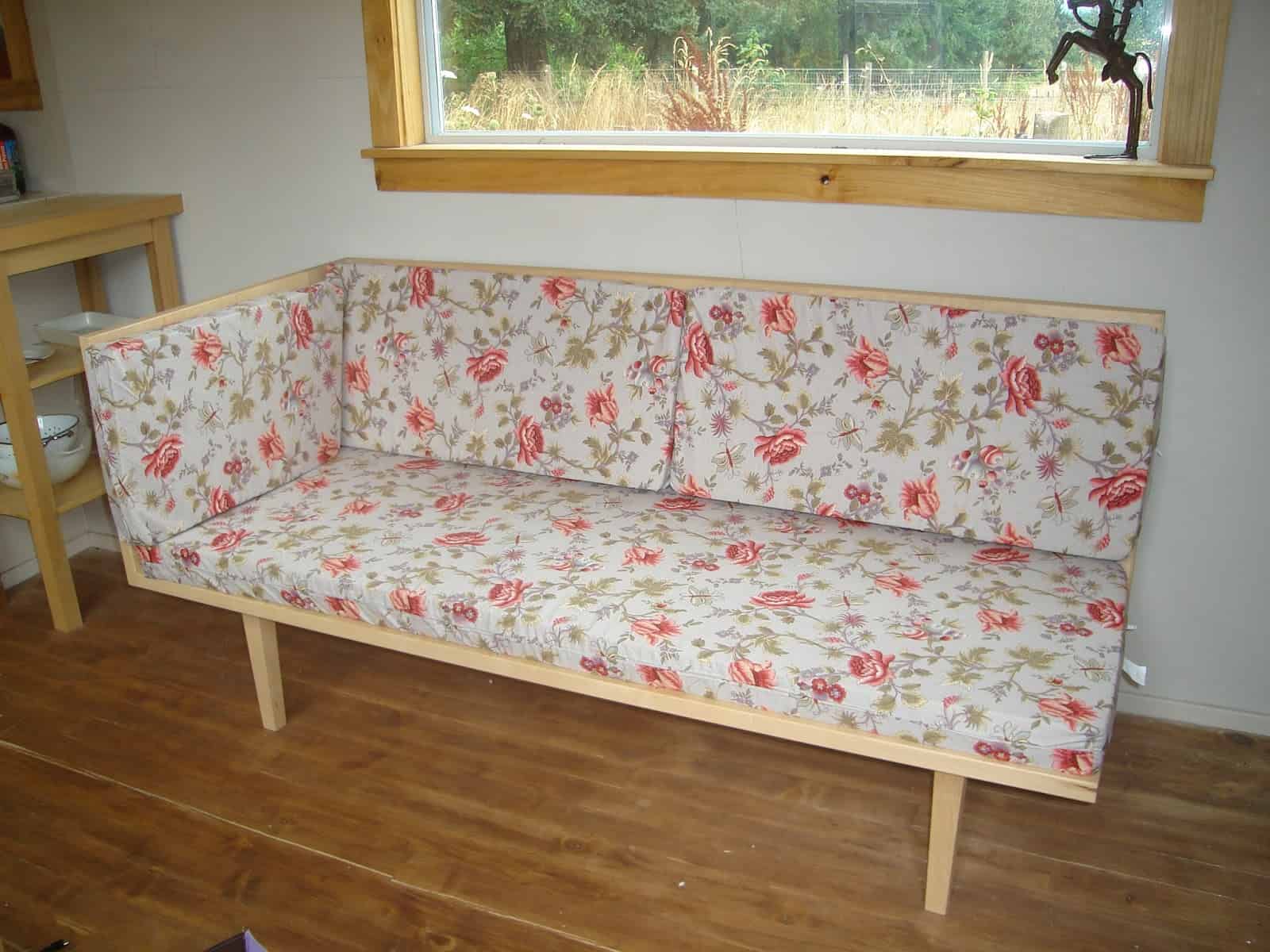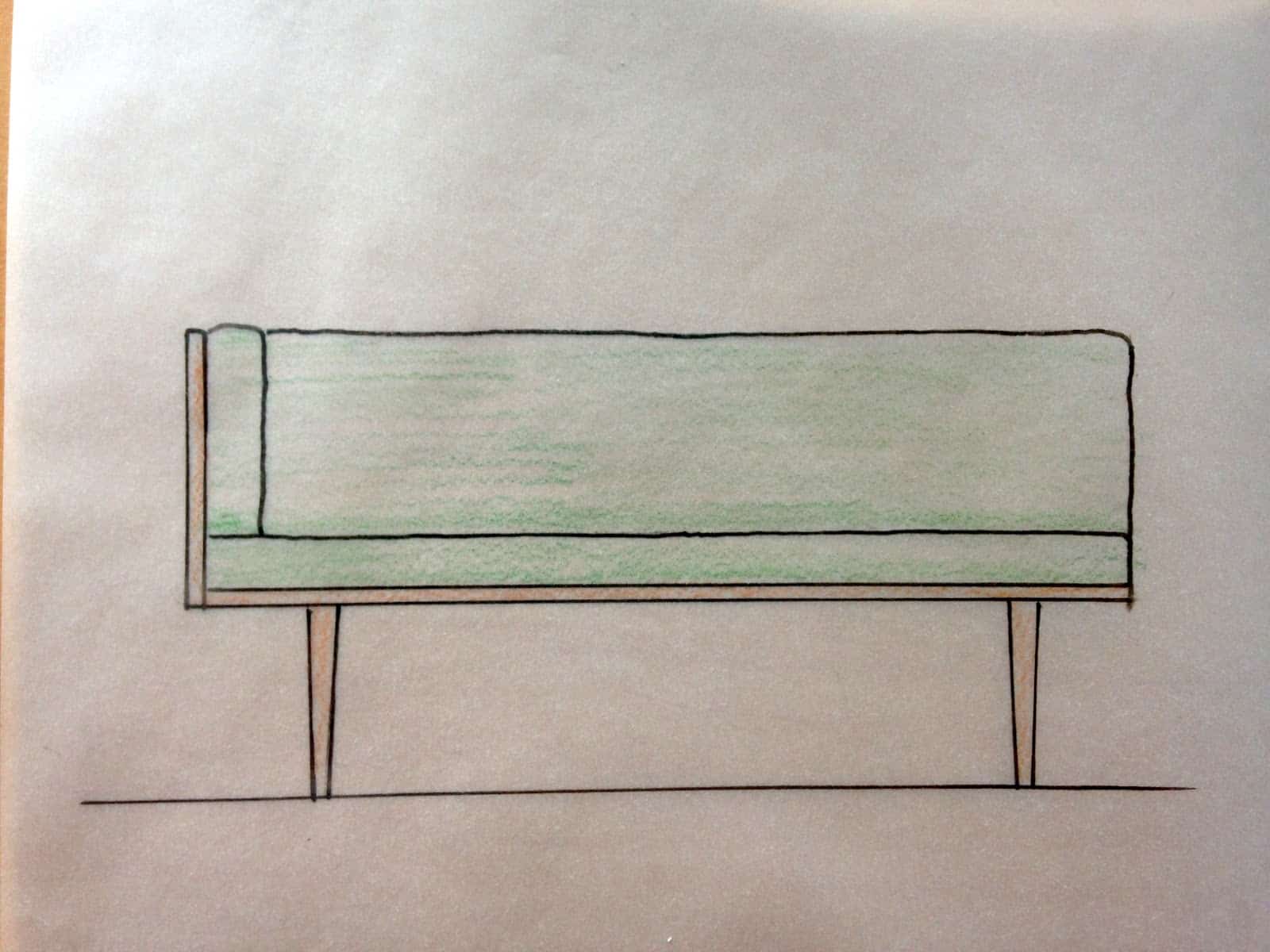Here is my chemical-free new sofa! I will go over in detail the material options for a DIY non-toxic sofa as well as the costs.

This post contains affiliate links to products I used. Upon purchase, I earn a small commission through affiliate links at no extra cost to you.
The non-toxic materials
The frame: We used maple for the frame because it is a hardwood that is non-aromatic (it does not have a strong terpene smell) since I was very sensitive to odorants. You can see my article on low-odor woods if you are sensitive to wood odorants.
The frame was made out of all solid wood, since I was not able to use plywood or other engineered woods indoors.
The finish: The sealer we used was Naturhaus Harmonic. The ingredients are: beeswax, carnauba wax, shellac, and a cosmetic emulsifier. It had a very sweet smell for the first two days.
While this is not available in North America anymore you would want to use either a non-toxic polyurethane or acrylic finish, a natural oil-based finish, or an alcohol-based shellac.
Examples would be: AFM Poly BP for a non-toxic polyurethane, polymerized linseed for an oil-based finish, or make your own shellac mixed with Everclear alcohol. My article on stains and sealers is an overview of all non-toxic finishes.
Glue: The glue used was Titebond which only needs a short time to offgas. Other options for wood glues include Roo Glue or even an all-natural hide glue. My article on non-toxic wood glues goes over the options.
Foam: The foam is a piece of 3″ natural latex. This has a natural rubber smell (which doesn’t fade completely with time) but does not give off VOCs at the level of conventional foam (it does give off some natural VOCs), nor does it contain flame retardants.
Natural latex can be organic (look for GOLS-certified) or non-organic. Dunlop can be certified organic (GOLS); I have never seen Talalay latex certified organic.
In terms of the two types Talalay and Dunlop, Dunlop is denser and that is what you would want to go with for a sofa. More specifically you could ask for the ILD rating which is the official rating on how soft or firm it is.
Many sensitive folks actually do better with polyurethane than natural latex so you would have to check out both options for yourself. Polyurethane does offgas some VOCs but it can be aired out for a couple of weeks first. Do verify that it doesn’t contain any chemical flame retardants.
One brand of better foam is White Lotus, which you can find in my article on beds.
Fabric: I used regular conventional fabric. If you want to go with organic fabrics, GOTs certified is the top of the line and it goes beyond just organic raw textile materials to encompass all the chemicals used to process and finish the fabric.
Another certification is OEKO-Tex 100, this is not an organic certification but it does ban some of the most harmful chemicals like PFAS (Per- and Polyfluorinated Substances) which are stain guard treatments.
In general, “performance fabrics” are the types that are likely to contain PFAS but many brands are now making the switch to non-PFAS fabric treatments as legislation over PFAS is changing.
I also want to note that fabrics made from recycled water bottles are actually more likely to contain higher levels of contaminants than virgin plastic, including phthalates and metals (source). So I would be cautious with recycled material fabrics.

Specs
Reinforcements: Metal brackets reinforce the frame so that the side piece can be leaned on. The inspiration picture had low sides that would not be as comfy; I didn’t think I’d be able to curl up on that sofa.
Dimensions: The dimensions are 28 inches deep (standard sofa depth), height from seat 16 inches (fairly standard), and length 5 feet (length was made to fit in my tiny house).
Costs:
The costs in 2015, in Canadian dollars were:
| Item | Cost |
| Maple | 468 |
| Metal Brackets | 200 |
| Labor | 40 hours |
| Latex Foam | 804 (from a local shop. Much cheaper on Amazon) |
| Fabric | 150 |
| Sewing | 237 |
| Total | $3,500 CAD |
This is expensive, even for a chemical-free sofa! You could save money by using plywood, sourcing a cheaper foam, and doing the labor yourself.
Alternatives: You may be able to find a ready-made or custom-made non-toxic sofa that works for you that is comparable in price. My non-toxic sofa post looks at the best options.
Corinne Segura holds certificates in Building Biology, Healthier Materials and Sustainable Buildings, and more. She has 10 years of experience helping others create healthy homes.
Whitney
Hello! Thanks so much for this post. My question is: where did you source your wood from and what questions did you ask to determine that is wasn’t treated in a toxic way? I know sometimes companies that sell wood apply a fungicide at certain times of the year which is toxic if used for furniture.
Really would like to just make my own furniture (Read: put the bug in my husband’s ear to make some furniture… He did just get a fancy new saw for these types of things…lol.) The non-toxic furniture brands are all so expensive! I’m not complaining at them. I’m sure it’s harder to maintain materials naturally, and of course they are appealing to a niche group of us that care and are sometimes willing to pay more for really awesome quality. So I don’t begrudge them in that. However, it all is set at a price point that I just can’t afford right now. Haha. Really appreciate your blog and your commitment to providing information on attaining a chemical-free household.
Corinne
This was many years ago. I think I just asked to see a sample of the wood. It was from a local mill.
William Jessie
nice
Wild Swan
We used wool batting, minimally processed, with an organic cotton cover and another removable cover, to make a futon. Very comfy. We are careful to air it out every day or at least put it on a rack indoors. With pillows and a throw, it is very civilized as a couch or spare bed. Yes, we have become cheaper with age.
Corinne
Very nice.
Mboris
Looks like consumer pressures on lawmakers and manufactures is working a bit. I was happy to see that ikea, elm and other mainstream stores are now carrying fire retardant free sofas. Granted not toxic free but I think it's a good start. If we could only pr source more the industry to force materials used to be non toxic completely for any living furniture and products sigh….
Patrick Warren
Great specs and ingenuity!
Anaphylaxing
pretty!